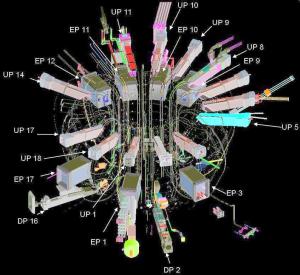The many wonders of ITER diagnostics
The eyes and ears of virtually all plant functions, ITER diagnostic sensors and accompanying systems will play an essential role at ITER. They will keep the reactor operating as efficiently as possible—and much more.
Just like in a future commercial reactor, diagnostics on ITER will help protect the plant and optimize overall output. But in the unique environment of ITER—the first reactor-scale fusion device—diagnostic systems will also have access to an important testing ground, allowing for the demonstration of techniques that can be used later by sensors in commercial power plants, as well as the collection of data for physics models that will contribute to the overall design of commercial plants.
Whether venturing into known or unknown territory, ITER diagnostics operate in a variety of modes. Some are active—for example, one system shoots a beam of particles into the plasma to interact with minute impurities, producing wavelengths that can be measured to unambiguously identify types of atoms. Others are passive. To detect sodium impurities, for example, sensors detects the wavelength that sodium emits in response to the ambient x-ray radiation that results from high temperature.
"Whenever you make a measurement there's going to be some error," says Diagnostics Physicist Christopher Watts. "The error may come from the uncertainty in the way you make the measurement, or it may come from the fact that the plasma is changing while you're making the measurement. Because the different diagnostic equipment has different sensitivities, you need multiple measurements to know what's going on."
Port plugs to protect sensor equipment
In addition to performing a wide variety of functions to measure a large number of parameters, ITER diagnostics must be robust enough to provide service under extreme conditions for as long as the ITER reactor is specified to last: 4700 hours of operating time over 20 years.
Scientists and engineers designing ITER diagnostics systems have to perform the balancing act of keeping the instruments safe, while at the same time ensuring they perform measurements. One way of striking this balance is by installing many of the sensors in "port plugs," minibus-sized containers inserted into one of 35 openings, or "ports," in the wall of the reactor. A port plug is full of shielding, with labyrinths in between the shielding to hold critical parts of the diagnostic equipment. One port plug usually carries several diagnostics.
"For maintenance, radiation-resistant robots will pick up the port plugs and deliver them to the ITER hot cell, where other robots will repair the port plugs and/or the instruments within," says Victor Udintsev, Port Plug Section Leader. "This transfer operation brings still another requirement concerning the robustness of the port plugs and the systems inside: they have to withstand the pressures of being moved without losing alignment, while at the same time being maintainable."
International project management
Diagnostics is an area where all seven partners play an active role in design and manufacturing, which means a great deal of international project management is needed. One hundred separate projects are underway to develop 60 instruments and the accompanying housing. In all, the diagnostic equipment at ITER has to measure 101 different parameters.
"We're building a few of the instruments ourselves, but most of the diagnostics are being built by our Members," says Robin Barnsley, leader of the Ex-Vessel Diagnostics Section. "This means we have a constant flow of meetings—design reviews, design progress reviews—among these parties. While some of the early-need systems have been delivered already, we are mainly at the stage now where we're discussing the construction and delivery of the systems."
For diagnostics close to the plasma, there are special requirements for construction, materials, and assembly techniques—for example radiation tolerance, thermal conductance, ultra-high vacuum compatibility, resistance to large electromagnetic forces, and high reliability requirements.
"We are currently reaching the end of the design phase for many of our First-Plasma systems, and we're building them for delivery in the next two or three years. These will be installed on the machine to be run in 2025."


